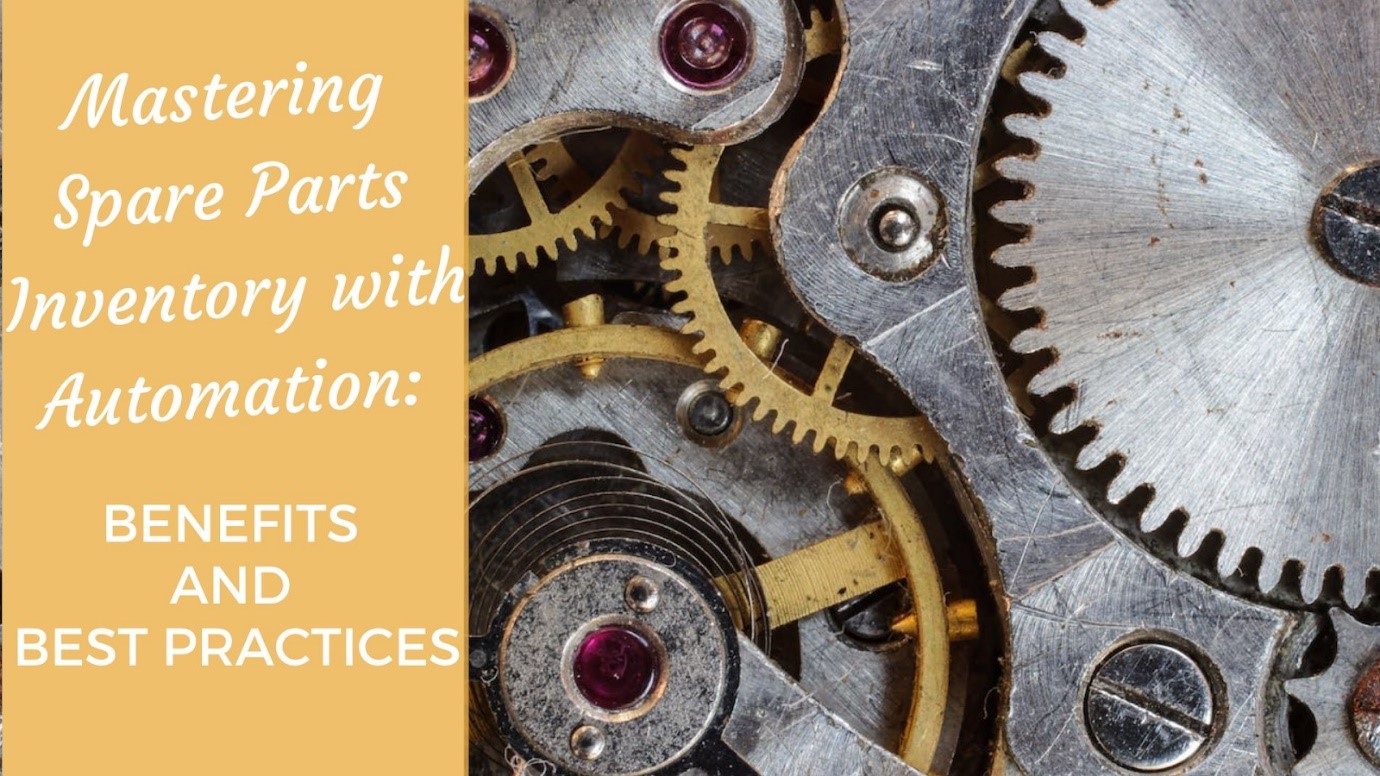
Mastering Spare Parts Inventory with Automation: Benefits and Best Practices
Madhurima Sanyal |
11 May 2024 |
12:13 PM
- Understanding Spare Parts Inventory Software
- Features of Spare Parts Inventory Software
- Benefits of Spare Parts Inventory Software
- The Pitfalls of Traditional MRO Inventory Management
- Best Practices in Spare Parts Inventory Management
- Getting started on Spare Parts Inventory Program
- Spare Parts Inventory Software for Maintenance
- Conclusion

The 7 Best Work Order Management System
Kirti Prakash 22 Jun 2024 | 07:02 AMDiscover the ideal workorder maintenance system to streamline your operations. Our comprehensive guide covers the latest in task management, scheduling efficiency, and maintenance tracking to boost productivity and minimize downtime....
In today's busy business world, automation helps a lot. It helps in managing things like inventory. Inventory is super important for keeping a business running well. In this blog, we'll highlight the benefits of spare parts inventory software. Also, how using automation can make your organization work better.
People often don't focus on their parts. They think these places don't help the company make money. They assume managing parts is easy. But this kind of thinking can cause problems.
If you ever try to fix these problems, it can be hard and uncomfortable. But there are things you can do to make sure problems don't happen, and your parts warehouse runs well.
Having an accurate spare parts inventory software helps the parts department be more prepared. It helps them respond to the plant's needs quicker. It can also save a lot of money because you won't need to rush order a part if you already have it in your warehouse.
Understanding Spare Parts Inventory Software
Maintaining inventory means keeping track of spare parts. Doing it well helps with keeping records, avoiding problems, using space and money. We also use numbers like MTTF (mean time to failure) to know when to replace things and keep them working.
This system is a one-stop solution for handling spare parts. It helps manage the entire lifecycle of spare parts. It keeps all spare parts information in one place. Tracks inventory levels and generates reports. Makes it easy to order the parts you need.
Maintenance locations use spare parts to know what they have and what they don't. When they run out, having spare parts helps finish work on time, avoiding long delays.
Features of Spare Parts Inventory Software
1. Automated Spare Parts Management Automated spare parts management makes businesses more efficient. It automates tasks and cuts down on errors in inventory. Automation also keeps data accurate and prevents unnecessary overstocking or wasted parts.
2. Track and manage Spare Parts Inventory Keep tabs on your spare parts with the Spare Parts Management system. Make sure you always have the parts you need. Avoid having too many or too few, which saves money and resources.
3. Improved budgeting and forecasting See everything in your spare parts inventory with the Spare Parts Management system. Predictive analytics help spot trends and patterns. Makes planning stock, purchases, and maintenance decisions better. Helps with budgeting and forecasting.
4. Improved visibility Get a full view of your inventory in real-time. Know how your parts are doing and if they're available. The system tracks purchases and generates reports on part conditions. Helps make better decisions about how to use your inventory.
Benefits of Spare Parts Inventory Software
It's usual to feel torn between saving money and having lots of inventories. Managers may reduce inventory to please management, but it's not the right thing to do. Low inventory causes problems like equipment downtime and unhappy customers. Following good inventory rules has benefits.
-
Quick Responses to Unexpected Repairs - Unexpected breakdowns happen. Keep spare parts for critical machines. These are important for production and safety. Quick repairs reduce downtime and losses.
-
Enhance Metric Analysis - To improve wrench time stats and efficiency, focus on spare parts control. Keeping critical parts minimizes employee waiting. This helps make wrench time measurements more accurate.
-
Reduce Repair Frequency - Ever done a quick fix on something broken? Don't want to fix it again soon? Keep enough parts in stock.
-
Cost optimization - Don't overstock but manage parts well. Saves money. Downtime costs a lot. Keeping essential parts helps avoid rushed shipping and downtime.
-
Higher Safety - Well-maintained machines are safer. Having spare parts reduces malfunctions. Protects employees and customers from accidents.
-
Enhanced Compliance - Some industries have rules for spare parts. Good inventory management keeps companies following these rules.
-
Data driven insights - To make your business better, you need to have the right information. Create reports about the things you care about, so you know what you have, where it is, and its usage. This helps you keep your business on the right path.
-
Reduce confusion around work orders and parts - Don't get mixed up with parts and work orders. Sometimes, a technician might use the wrong part because it looks a lot like the right one. To prevent this, use special barcodes for each part and keep track of your inventory all the time.
The Pitfalls of Traditional MRO Inventory Management
Traditional methods of managing Maintenance, Repair, and Operations (MRO) inventory have their limitations. Using tools like Excel, paper records, or bad software can cause mistakes. They can lead to inefficiency in the system. Waiting until something breaks to order parts can make the machines stop working for a long time
Here are some common challenges associated with traditional MRO inventory management:
1. Finding the Inventory Level "Sweet Spot": Having too much stock can fill up storage and cost too much. But having too little can make it hard to finish making things on time.
2. Overstocking of Obsolete Parts: Holding onto obsolete items takes up valuable storage space.
3. Lack of Centralization: Inconsistent tracking and reporting can lead to errors and duplicate orders.
4. Inaccurate Records: Outdated or erroneous data can hinder decision-making and responsiveness. To solve these problems, organizations need a complete plan for handling MRO inventory.
Best Practices in Spare Parts Inventory Management
Ignoring spare parts management can lead to delayed production and safety concerns. This means lower efficiency, decreased competition and fixing things only when they break. To mitigate these risks, consider implementing the following best practices:
1. Centralized Inventory Management: Establish a centralized system for accurate and up-to-date inventory tracking. Use software to automate the process and reduce the risk of human error. This centralized approach prevents duplicate orders and enhances coordination among team members.
2. Regular Inventory Audits: Check your stock often to make sure nothing gets lost. Keep an eye on your suppliers and use your storage space smart.
3. Categorize and Organize: Segregate parts by categories such as value, usage, client, or department. This organization streamlines retrieval and reduces over-ordering.
4. Cross-Functional Teams: Create cross-functional teams with expertise in inventory control to oversee the management process. These teams should know when to reorder parts and which items to order on demand.
5. Consider Third-Party Solutions: Check third-party inventory management providers. Especially if your staff has specialized tasks that need dedicated attention.
Getting started on Spare Parts Inventory Program
Step 1 - Proactive Maintenance is key
Move from fixing when broken to fixing before. Machines wear out over time. Yet, it may not be possible to always stay reactive. But don't focus on reactive maintenance for cost savings. To succeed in spare part management, stop problems early.
Step 2 - Create standard procedures of operation
They guide workers in fixing things the right way. Make sure machines run well. Digital checklists and inventory systems work together for tracking parts. Use a mobile CMMS with parts inventory like Proptor. It helps to organize maintenance tasks. Technicians can also log used parts in real time.
Step 3 - Adopt proper measures of Inventory Control
You don't need every single part. Stock the most important ones. Keep records and categories organized. Check your inventory often. Look for old or too much stock. Use user friendly software like Proptor to simplify.
Step 4: Know your lead times
Learn how long it takes to order and get parts. Helps decide what and how much to stock. Put important parts before less important ones. First order parts that take a long time to arrive. Avoid rushed shipping and extra costs.
Step 5: Check your risks
You can't prevent all breakdowns. Calculate how likely each asset is to fail. Use a Failure Mode and Effects Analysis (FMEA).
Step 6: Adopt security measures
Only let authorized people in the warehouse. Track spare part movement. Use security cameras. Train staff to handle orders and count parts.
Spare Parts Inventory Software for Maintenance
For an efficient maintenance team, use software that helps track spare parts. It can remind you when it's time for maintenance. It also ensures you have the correct parts and cut down on equipment downtime.
For example, Proptor software is a great option. It keeps all the information about spare parts in one place. It shows how parts are being used real time and makes it easy to order more spare parts.
It also helps with keeping records and understanding the data. Maintenance managers benefit. Those needing parts benefit. Companies supplying parts benefit. Technicians benefit. Work becomes more efficient. Downtime decreases.
Conclusion
This blog talks about how important it is to manage spare parts well for businesses. It says that using computer programs can help a lot. These programs help with things like tracking parts and making sure you have enough but not too many. It also talks about the benefits of doing this, like fixing things faster and saving money.
It also highlights gaps in traditional ways of doing this and suggests better ways. It stresses on starting a program for managing spare parts like Proptor. Using modern tools can make businesses work better and compete well in today's world.
In the end, using automation is changing the way we manage spare parts for maintenance. It helps organizations work better, avoid costly downtime, and stay competitive.
Use modern methods and tools. Like Proptor software. Make maintenance better. Stay competitive today. If you want to see how Proptor works, we can schedule a demo. It's a step towards more accurate and efficient inventory management.